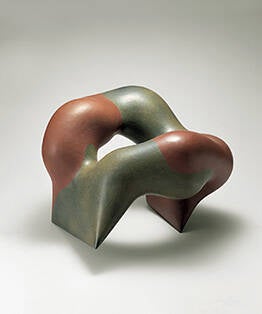87. Kuriki Tatsusuke 栗木 達介

Kuriki Tatsusuke was born in Seto in 1943. He came from a traditional ceramic family in Seto and only developed his interest in ceramic sculpture as a student at Kyoto City University of Arts, where he was taught by Tomimoto Kenkichi, Fujimoto Yoshimichi and Kondo Yuzo, among others, all living national treasures. It was during this period of Japanese ceramic art that Sodeisha's avant-garde views flourished, opposing traditional, functional ceramics, characterized as "objects with an opening." Sodeisha sought non-functional objects, without purpose or function other than that of art object. Kuriki Tatsusuke, however, did not participate in this, possibly because it clashed with the conceptions of pottery he had grown up with. Instead, he sought new possibilities within functional ceramics, using refined and precise techniques inspired by traditional porcelain. Unlike traditional pottery, which often views imperfection as aesthetically beautiful, Kuriki Tatsusuke avoided cracks or deformities and instead introduced unusual forms created with refined ceramic techniques. In doing so, Kuriki Tatsusuke always relied on the aesthetic potential of the conventional vessel shape and pursued his goals with designs in which the shape and surface of the object complement and enhance each other, using techniques that became increasingly refined. Because form is an important integral part of the decorative nature of his objects, his works remain within the conventional concept of ceramics but are also part of the modern era. Kuriki Tatsusuke is therefore considered one of the most important figures of the late twentieth-century Japanese ceramics movement. However, his output was relatively low, which may be due to the careful approach to his objects that were realized only after extensive research into design and techniques. For example, he researched and developed only two main themes for more than a decade. In his silver and green series, he explored the use of wide, interlocking silver bands on round, slightly asymmetrical forms. In his silver and red series, he explored the cylinder as a fundamental form.
Kuriki Tatsusuke had numerous solo exhibitions and won many awards, including the 5x Asahi Ceramics Exhibition Main Prize, the Aichi Selection Art and Culture Prize and the Kyoto Art and Culture Prize. In 1986, he was appointed lecturer at Kyoto City University of Arts, which was an important way for him to pass on his vision and methods. In 1993, he was appointed professor and would focus exclusively on teaching and hardly be active as an artist anymore. He passed away in 2013.

Lleaning vase with geometric pattern, 1983 - Joan B. Mirviss LTD

Wind Image II Vessel, 1988 - Victoria and Albert Museum

Walking Circle, 1976 - Musée Tomo Tokyo

Blue color work, 1969 - National Museum of Modern Art, Tokio

Maak jouw eigen website met JouwWeb